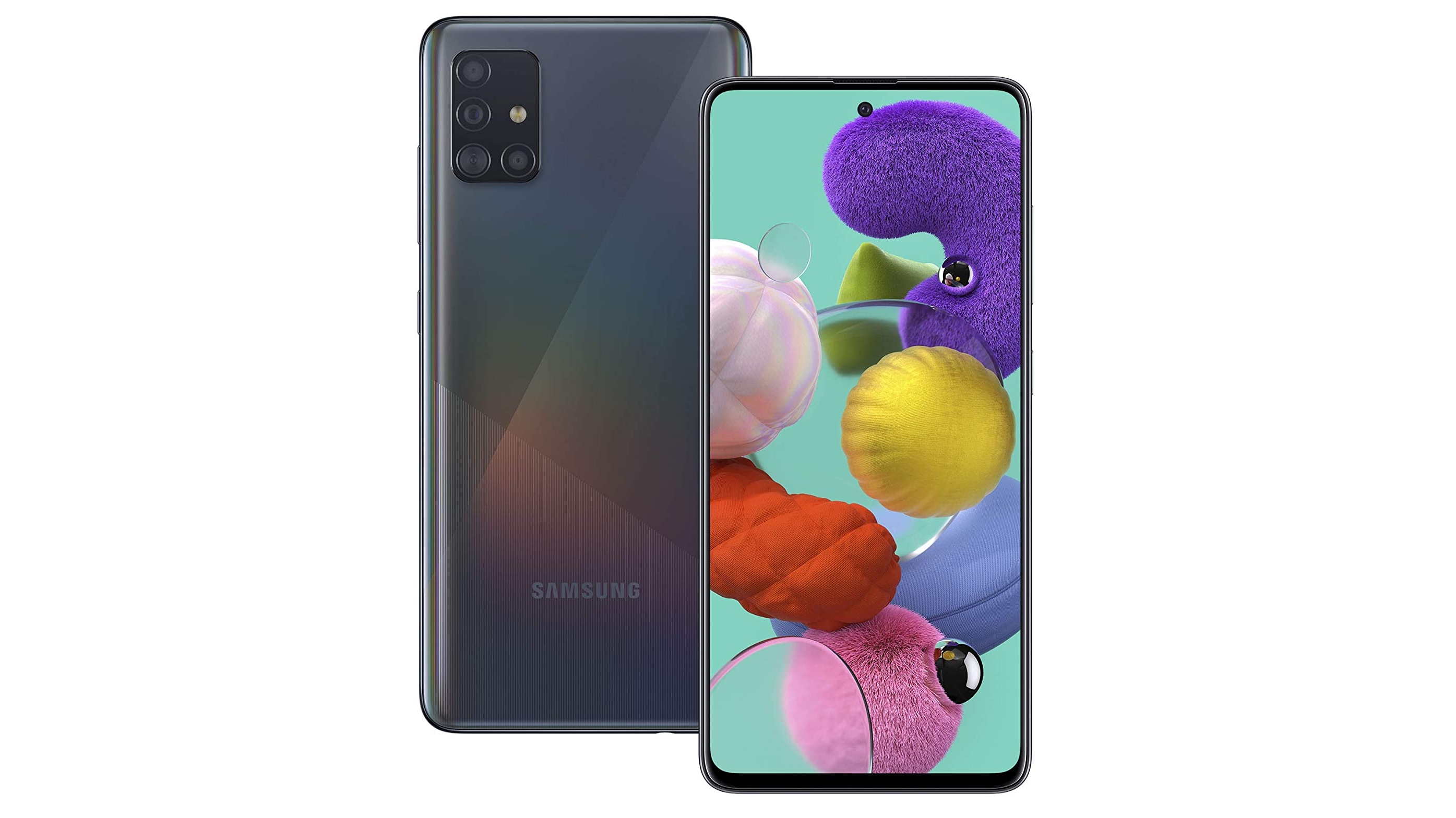TechRadar Verdict
The Samsung Galaxy A51 is an affordable way to get a good-looking Galaxy phone, but it makes Android feel a little too slow for us to wholeheartedly recommend it.
Pros
- +
Bold OLED screen
- +
Has a headphone jack
- +
It’s a Samsung Galaxy, without an S20 price
Cons
- -
Feels slower than most at this level
- -
Poor fingerprint scanner
- -
Unusually prominent punch-hole camera
Why you can trust TechRadar
The Samsung Galaxy A51 is a relatively affordable Android phone you might buy if you can’t stretch to the Samsung Galaxy S22 or Galaxy S21, or can't pick up a Samsung Galaxy S20 Fan Edition in your region.
A lower price comes with obvious downgrades from Samsung's pricier phones. We'll cover these in detail further into this Samsung Galaxy A51 review, but in brief the back is plastic rather than glass, the cameras aren’t as good (even if there are five of them), the chipset is less powerful, and nice-to-have extras like water resistance are absent.
Classic Samsung traits you do get in the Galaxy A51 include a bold AMOLED screen, and software that looks just like that of the Galaxy S21 series.
At $399 / £329 / AU$599 the Samsung A51 seems a sure-fire hit. However, there are more obvious performance issues here than in alternatives like the Moto G8 Plus and Oppo Reno 2Z. Android moves a little too slowly. Parts of the camera app do too at times. Thankfully, games aren’t affected as badly – PUBG fans, don’t worry.
Don’t expect miracles from the cameras, either. As with many affordable quad-camera phones, this feels more like a dual-lens handset with some half-baked extras, although its tertiary macro camera is better than most in this class and does offer a different way to take photos.
Since we've reviewed this device, Samsung has also introduced a slightly tweaked version called the Galaxy A51 5G. We've yet to test that device properly, but the big difference is that it features a different chipset with additional 5G connectivity.
The company has also now followed up the Galaxy A51 with the Samsung Galaxy A52 5G. This - as well as having 5G - has other upgrades such as a 120Hz screen, a bigger 4,500mAh battery, more megapixels on its main camera, and a different chipset.
Sign up for breaking news, reviews, opinion, top tech deals, and more.
Of course, it also costs more, so the Samsung Galaxy A51 is still worth considering - it's not one of the best Samsung phones but it is still a solid choice.
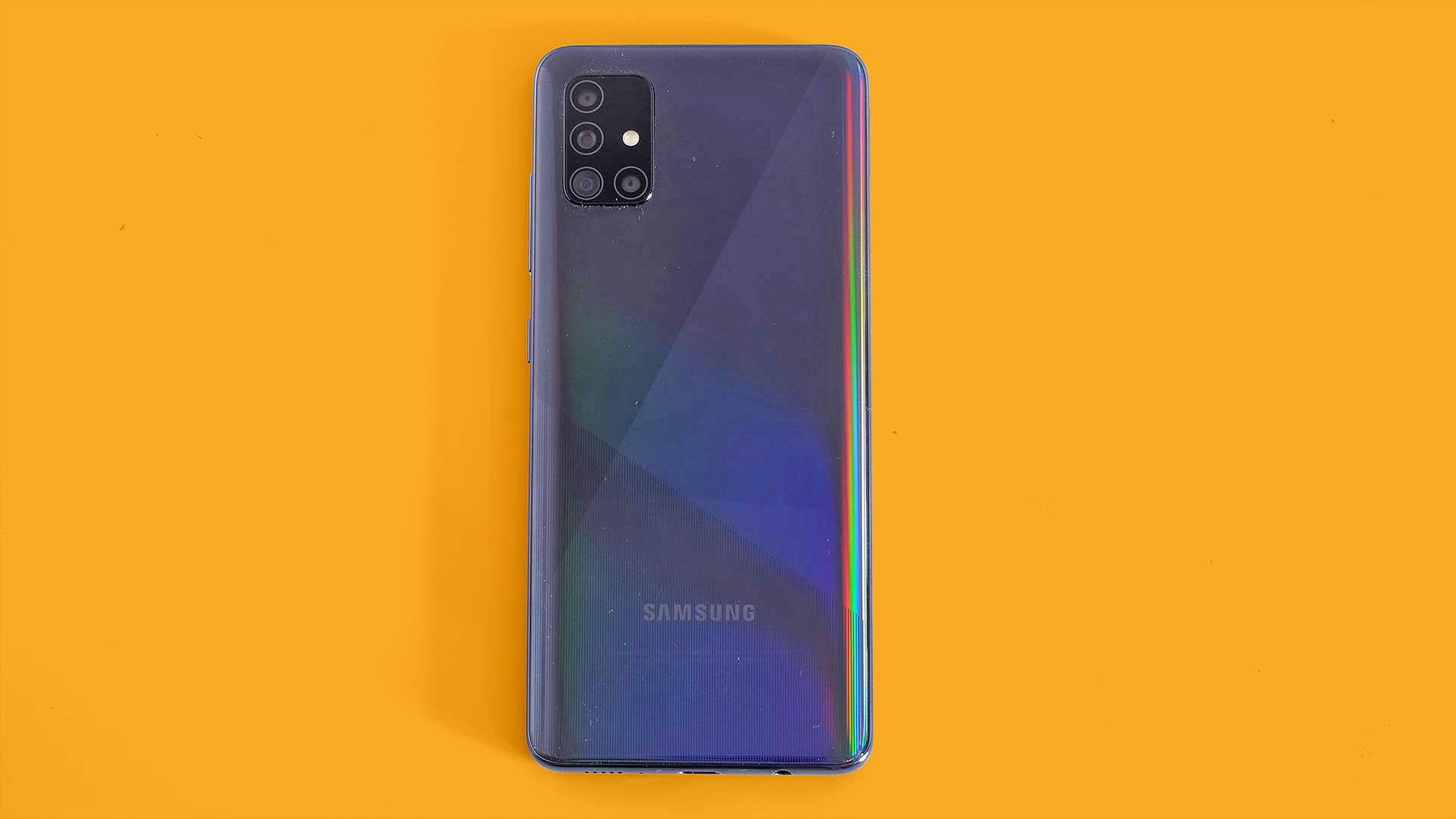
Samsung Galaxy A51 review: price and availability
- Out now
- Costs $399 / £329 / AU$599
Weight: 172g
Dimensions: 158.5 x 73.6 x 7.9mm
Display size: 6.5-inch
Resolution: 1080 x 2400
Chipset: Exynos 9611
RAM: 4GB
Storage: 128GB
Rear camera: 48MP + 12MP + 5MP + 5MP
Front camera: 32MP
Pre-installed software: Android 10
Battery: 4,000mAh
Charging: 15W wired
The Samsung Galaxy A51 costs $399 / £329 / AU$599 so it's a fairly affordable phone, and it competes most with the likes of the OnePlus Nord at £379 (around $480, AU$680), and the Moto G 5G Plus at £299 (about $375, AU$535).
Other alternatives include the iPhone SE (2022) at $429 / £419 / AU$719 and the Google Pixel 4a at $349 / £349 / AU$599. vIt's worth pointing out the first three of those are 5G phones, while the last one, and the Galaxy A51, aren't.
Well, the model we reviewed isn't, but Samsung subsequently released a 5G version for $500 / £429 (roughly AU$700). While it's pricier than the 4G version, it's not too expensive as 5G phones go.
Of course, the prices we listed above are launch prices, but if you shop around you can likely find the Samsung Galaxy A51 for less now. At the time of writing we've seen it on sale for $290 / £230 / AU$390.
You can pick up the Samsung Galaxy A51 in most countries Samsung sells phones, although the 5G version isn't available in Australia. This is curious, and we don't know if that's a permanent state of affairs or just temporary.
If you have a bit more to spend though you might also want to consider the newer Samsung Galaxy A52 5G.
Samsung Galaxy A51 review: design
- 158.5 x 73.6 x 7.9mm, 172g
- Clad in plastic but with a distinctive look
- Black, white, blue, and pink finishes
The Samsung Galaxy A51 offers some of the design traits of Samsung's higher-end phones. But there are a few giveaways that it is not part of the pricey Galaxy S series.
Display borders are slim, and the front camera sits in one of Samsung's ‘Infinity O’ punch-holes. However, the back is plastic rather than glass and the front camera does not merge into the front glass anywhere near as well as most.
Sure, the front glass covers the selfie camera. But the layers below are far more reflective, making the Samsung A51's selfie camera stand out like a tiny little monocle.
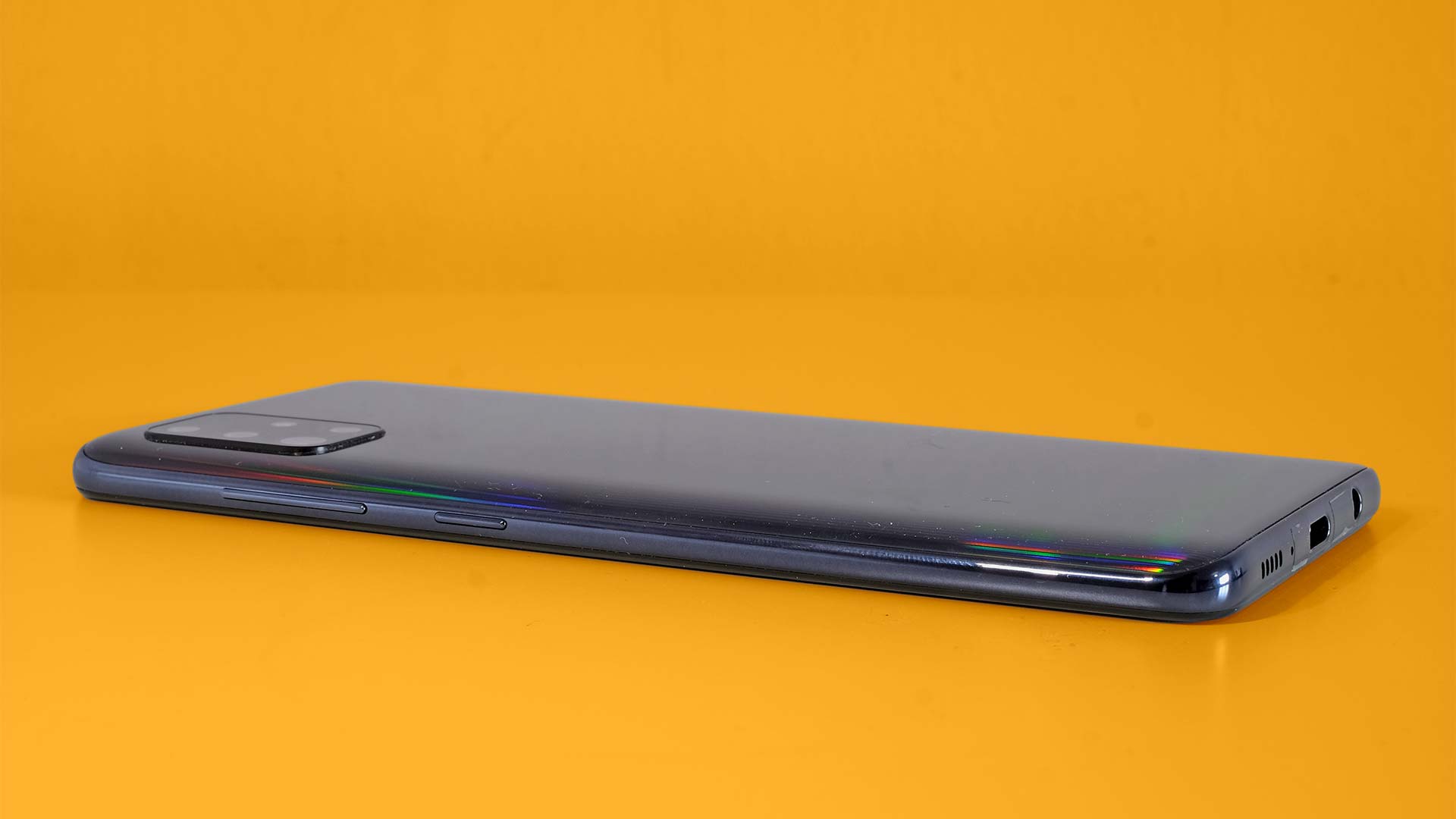
Side buttons are plastic too. The result? The Samsung Galaxy A51's build is closer to that of a Motorola Moto G8 or Oppo A5 2020 than a high-end Samsung.
It does have a somewhat distinctive back, though. Like other recent A-series phones, the Samsung Galaxy A51 has a finish of intersecting lines, cutting shapes onto the back, each with a slightly different look. The bottom part has a pinstripe texture of thin lines, for example, sitting under the top plastic layer.
This is a relatively subtle look, but when the Samsung Galaxy A51 catches the light you'll see shimmering rainbow tones that tend to pool into laser streaks across the curved edges.

It can pass for an expensive Samsung at a distance, particularly as the large four-lens camera housing on the back looks advanced. This phone is a fair size too, made for media and wider than the Galaxy S20.
Like most phones at the price, the Samsung Galaxy A51 offers no official water resistance. But it does have a 3.5mm headphone port, which is handy if you are yet to make the jump to Bluetooth headphones.
It has an in-screen fingerprint scanner too, another attempt to make the Samsung Galaxy A51 seem like a high-end phone. However, this is not a great scanner. It is slower than most and will fail to recognize fingers if they are even slightly wet, or if you are not very careful about the position of your thumb.
Cheaper phones with less trendy rear scanner pads unlock more quickly and reliably.
Samsung Galaxy A51 review: display
- 6.5-inch 1080 x 2400 Super AMOLED screen
- Infinity-O punch-hole
- Decent screen but has a blue hue
The Samsung Galaxy A51 has a 6.5-inch Super AMOLED screen with a 1080 x 2400 resolution. This is an instant win on paper, as many phones at the price have LCD screens.
OLEDs tend to deliver much deeper color, and always have better contrast than LCDs, because they use light-up pixels rather than a universal backlight. This is not one of Samsung's greatest OLED panels, however, and there are a couple of obvious issues.
Less advanced OLED panels take on a slightly blue hue from an angle, usually when you turn a phone screen left or right. It's rarely a major problem, because we all look at our phones front-on, right?

But this effect comes from the other direction in the Samsung A51. Hold it in a relaxed, tilted manner and the top of the display has this blue tint. It is only obvious when significant parts of the screen are white, as in web pages for example, but instantly shows this is not one of Samsung’s best OLEDs.
The Samsung Galaxy A51 does get the other usual benefits of an OLED display. Its optional Vivid screen mode looks very saturated, and contrast in a dark room is clearly far better than LCD phones at the price.
Screen brightness is fairly good too, if not in the same league as the Galaxy S20. Maximum brightness seems conservative when used indoors, but the Samsung Galaxy A51 kicks up a gear when taken outdoors on a bright day. It also fiddles with color and contrast to increase visibility in tough conditions.

It’s not quite bright enough to let you watch movies in direct sunlight comfortably, but the interface and web pages look fairly clear.
The Samsung Galaxy A51 is also certified for HD Netflix from launch, but it does not support HDR video.
Issues aside this is a good phone for video streaming, although anywhere but indoors the reflective (if tiny) punch hole camera is doubly distracting.
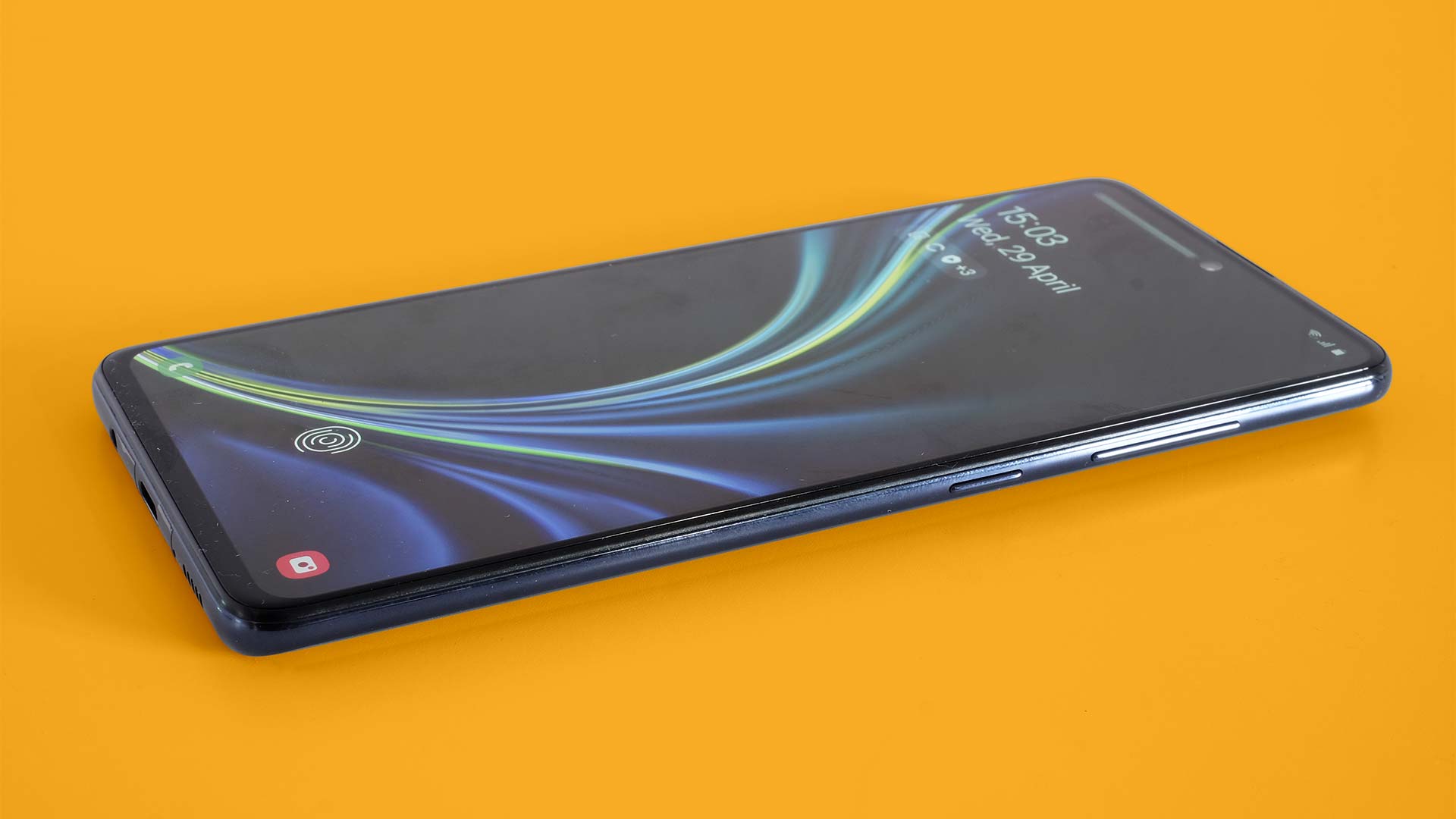
Samsung Galaxy A51 review: camera
- Quad-lens rear camera
- 48MP, 12MP, 5MP and 5MP sensors
- Ultra-wide, depth and macro secondary cams
The Samsung Galaxy A51 has four rear cameras. But when you first boot up the camera you may be left wondering what half of them do.
There's no zoom, which is the classic sign of a multi-camera setup where extra lenses are used to bulk up the numbers. We can't blame Samsung completely for this, as it is not easy to fit a good zoom camera into a reasonably priced phone.
You get a 48MP main camera, a 12MP ultra-wide one and a pair of 5MP cameras used for close-up macro images and for background-blurred depth shots.
It's not hard to spot the filler: those two 5MP cameras. But this case is much less egregious than, for example, what Oppo has tried recently. The Oppo A9 2020 has a couple of intensely useless 2MP cameras.
The Samsung Galaxy A51's 5MP macro camera will not see you win a Wildlife Photographer of the Year award, but it is fun to play around with. You can get extremely close to your subject, and shoot objects the main camera won't even focus on. Its main issue, other than only passable image quality, is blurring. A little handshake movement will ruin your photos unless the light level is good.
This is still a useful macro camera, and offers another way to think about how you take photos. The Samsung Galaxy A51 is one of the cheaper phones we've seen with an acceptable macro camera. Samsung does not seem too proud of it, though, as you have to dig into the extended menu to find the macro mode. We would not be surprised if many A51 owners never do.
The main camera's sensor is the Sony IMX582, seen in a stack of Chinese phones. Like most 48MP phone sensors, it takes 12MP images and uses pixel binning to improve image quality.

Fine texture detail is not in the same league as the native 12.2MP sensor of the Google Pixel 3a. There's a processed look to images close up that's not seen in the best-in-class camera phones, but general image quality is good. Like other Samsung phones the Galaxy A51 uses stacks of HDR processing to make the most of any scene you shoot.
There are a few little issues. You don't get a reliable view of the shot you take in the camera app. What you see is before the processing has been applied, with no indication of how much better HDR will make the picture look. The good news? That means the final image will actually be a lot better.
A lack of a good preview image is common in cheaper phones.
The Galaxy A51's ultra-wide photos are also far more saturated than the standard wide shots, which makes grass look unrealistic, almost neon. This aside, ultra-wide images are solid. They offer lower dynamic range and less shadow detail than the main camera, but this is to be expected at the price. Wide shots are still well worth taking.
Our final sensor helps with Live Focus photos, Samsung's version of a Portrait mode where the background is blurred out. Other phones manage to create depth maps without a dedicated depth sensor, and here the blurring usually refuses to kick in if your subject is more than a couple of meters away.
Still, the blurring effect is charming enough, and reasonable object recognition means it won't always be immediately obvious the shot was taken with a phone rather than a larger camera with a wide aperture lens. The Samsung Galaxy A51’s Portrait mode still tends to fall apart with complex subjects, as it will in most phones.
Night shooting is not a Galaxy A51 highlight. It can brighten up scenes and there is a dedicated Night mode, but we don't see anything like the low-light smarts Samsung put into the Galaxy S20. Dark shots often look blotchy and are low on detail. The Night mode helps a bit. But only a bit, and it takes several seconds to finish the image.

There are some issues with the Samsung Galaxy A51’s basic camera experience too. Its app is not particularly quick to load up and get to the point where you can shoot. Switching between the ultra-wide and standard views takes too long, and we have seen a few bouts of continual crashes.
While those crashes likely won’t be an issue for long, the general sluggishness may be. Camera performance issues are intermittent rather than constant, but we did notice them regularly while out shooting.
The Samsung Galaxy A51 can shoot video at up to 4K resolution, 30 frames per second (fps). Why no 60fps? It is a limit of the Sony IMX582 sensor, as the processor can handle 4K encoding at up to 120fps.
We recommend sticking to 1080p most of the time, as 4K video is completely non-stabilized, and will therefore look rubbish unless you stand still. There’s also no way to switch between wide and ultra-wide views as you shoot, a neat form of on-the-fly editing available in other phones. So the Samsung Galaxy A51’s video is pretty basic.
Its front camera has a 32MP sensor and is handy for all sorts of selfies. While image quality does not reach any new heights, with a slightly processed look to fine details even in good lighting, selfies in fairly dark rooms still look bright. You’ll simply, as ever, see less detail in worse lighting.
Samsung Galaxy A51 review: camera samples
















Samsung Galaxy A51 review: software
- Android 10
- Samsung One UI
- Some lag
The Samsung Galaxy A51 runs Android 10 with the Samsung One UI software on top. This means it looks very similar to a Galaxy S20.
It is one of the most coherent and confident-looking custom interfaces around, although we strongly recommend increasing the number of app rows and columns used as standard. The Samsung A51 has a toy-like look when you first turn it on thanks to the wide icon spacing.
To change this, long-press an empty part of a home screen and select 'Home Screen Settings'. You'll find the relevant controls there. We’d already made the change before taking the photos seen in this review.

The basic layout of One UI is perfectly good, if different to standard Android. Its apps menu uses pages rather than one long scroll of app icons, but you can also arrange them into folders should you like to keep your phone organized.
The Samsung Galaxy A51's software looks like that of a top-end Samsung, but it doesn't feel the same. There's significantly more lag here, apps take longer to load, and there are some pauses we were a little surprised to see in a phone at the price.

Transition animations occasionally stutter, and at times the keyboard takes a moment to appear when you tap a text box. The Oppo Reno 2Z and Moto G8 Plus are smoother.
This slowdown is not infuriating. It is minor. But it is an unavoidable reminder this is not a top-end phone, and general performance belongs to the class below. $400 / £330 buys you a lot of phone, even if many spend over $1000 / £900 these days.
The lag factor is worth considering if you plan to buy the Samsung Galaxy A51 outright as a way to save money on expensive contracts, after years on the high-end Android upgrade treadmill.

Samsung Galaxy A51 review: performance
- Samsung Exynos 9611 chipset
- 4GB of RAM
- 128GB of storage
So why is the Samsung Galaxy A51 slow off the mark? Lag like this can be caused by under-optimized software, which can be fixed in an update. But it may also be down to the chipset or RAM.
The Samsung Galaxy A51 has an Exynos 9611 CPU, not the Qualcomm Snapdragon kind we tend to favor. It is technically similar-ish to the Snapdragon 665 used in the Motorola Moto G8.
There are four Cortex A73 cores clocked at 2.3GHz, and four lower power Cortex A53 cores at 1.7GHz. It's the same dual-cluster arrangement seen in almost every phone at the price. And it earns the phone 1,288 points in Geekbench 5, very similar to the Huawei P30 Lite, the Motorola Moto G8 and Motorola One Action, and the Google Pixel 3a.
The GPU is a triple-core Mali-G72, which again offers very similar graphical power to the Adreno 610 and 612 graphics chips used in Qualcomm-powered alternatives.

Our test Samsung Galaxy A51 has 4GB of RAM. It should be enough to keep Android quick, leaving the use of an Exynos chipset as the most obvious hardware weak link here. Today they are rarely as good as the closest-spec’d Qualcomm Snapdragon chipsets.
Samsung Galaxy A51 review: gaming
- Gaming performance is mixed but generally solid
- Mono speaker but reasonable quality
The Samsung Galaxy A51 performance with games that use the Vulkan graphics standard seems fairly poor. You have to run Ark: Survival Evolved at low graphics and reduced resolution to get it to a playable state, with greater visual sacrifices than a Snapdragon-powered phone with a GPU that should be similarly capable.
Other games tend to fare much better. PUBG runs perfectly well with ‘HD’ graphics and anti-aliasing switched on. Call of Duty: Mobile is smooth too.
With most titles you get an experience fairly close to that of a more expensive phone, which is a sweet consolation after the general performance hitches. The Samsung Galaxy A51's screen also makes games look great. But there’s a lot of Snapdragon-powered competition at the price, and they seem to offer more consistent results.
Speaker quality is fair. There's a single driver on the bottom, one with solid maximum volume. Treble is a little abrasive maxed-out and we'd ideally like a stereo array, though.

Samsung Galaxy A51 review: battery life
- 4,000mAh battery
- 15W charger
- One-day battery life
The Galaxy A51 has a 4,000mAh battery, which is about as low a capacity as we are comfortable with in a phone with a 6.5-inch screen.
Its longevity is reasonable, if nothing more. We haven’t regularly had to recharge the Samsung Galaxy A51 in the afternoon just to make sure it makes it to lights-out, but we are usually left with little charge by the late evening.
We also tested how much video playback eats the battery at maximum brightness. Here the Samsung A51 benefits from an efficient OLED panel.
On our first attempt a 90-minute video took just 6% off the charge level: an excellent result.
However, this phone holds on to its reporting of ‘100%’ charge level for quite some time. On a second attempt, with the battery level starting below full, it lost 10%. We also re-ran the test in bright conditions to make the Samsung Galaxy A51 use its boosted brightness mode. It lost 13% charge at max brightness. All of these results are good, suggesting any shortfall in battery is not down to the display.
The Samsung A51 does come with a fast charger, a lower end 15W one. Charge speed is not close to the "50% in 30 minutes" gold standard. A 30-minute charge from flat took the phone to 31% battery, and a full charge will take around two hours.
The phone does not support wireless charging, but we would be surprised if it did at the price. You only tend to see wireless charge support in more expensive phones.
Samsung Galaxy A51 review: verdict
The Samsung Galaxy A51’s draws are similar to those of other mid-price Samsungs. Its OLED screen is colorful, contrast is ultra-high, and Samsung’s software looks good.
Samsung’s brand has never seemed stronger among Androids too, now that we’re more likely to recommend an Oppo phone than one made by Sony, HTC, or Huawei.
One important part of the A51 is below average at the price, though: performance. The Galaxy A51 makes Android feel a little slow, more so than the usual app load discrepancy between a good affordable phone and a top-end one.
Other parts of the phone are solid. And complaints about low-light camera performance, the opportunism of the patchy ‘quad-camera’ array, and less than flagship level screen brightness apply to most at the price. That the Samsung Galaxy A51 operates more like a phone from the tier below is hard to forget, though.
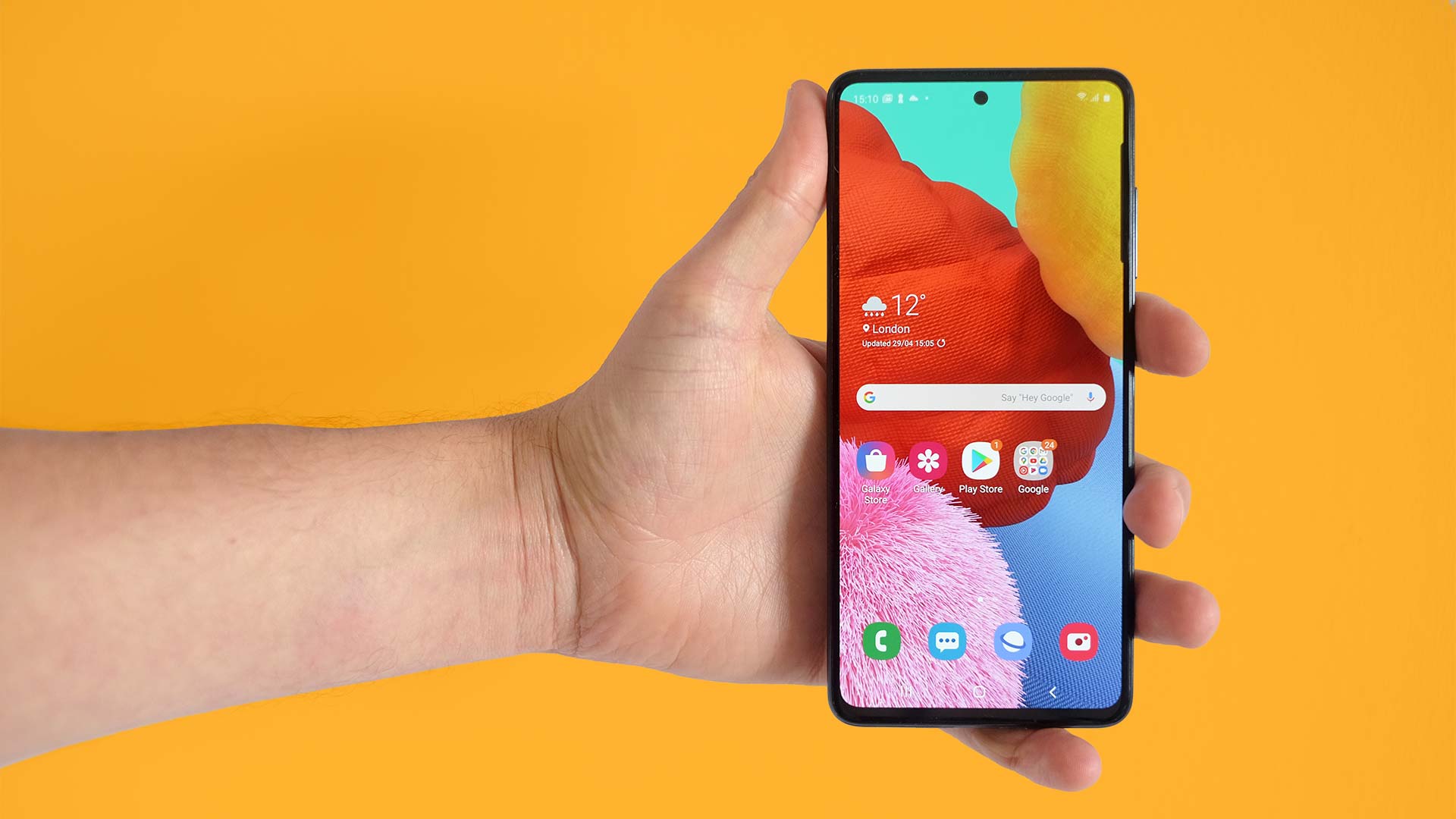
Who's this for?
The Samsung Galaxy A51 is for those after a relatively affordable phone who would rather own a Samsung than an Android from Motorola, Oppo or Xiaomi.
Those companies tend to offer a little more for your money, but the draw of the Samsung Galaxy series is strong.
Should you buy it?
This phone is not one of our favorites at the price, largely because of its flawed general performance. It feels a little too slow day-to-day at the price, even if it can run most popular 3D games perfectly well.
Some alternatives also offer better battery life, like the Oppo A5 2020. You’d better appreciate Samsung’s particular strengths before buying a Galaxy A51. These include a rich OLED screen and a good-looking Android interface.
Also consider
If our Samsung Galaxy A51 review has you considering other options, check out these other smartphones that you might like.
Motorola One 5G
The Motorola One 5G - also known as the Moto G 5G Plus - is marginally cheaper despite supporting 5G, which the Galaxy A51 doesn't. However, it has similar flaws, including the fingerprint scanner and cameras.
Read our full Motorola One 5G review
iPhone SE (2022)
If you want an iPhone rather than Android then the iPhone SE (2022) is the top affordable choice. That said, this does cost more than Samsung's phone, and packs generally better specs, including a faster chipset and 5G.
Read our full iPhone SE (2022) review
Samsung Galaxy A52 5G
The Samsung Galaxy A52 5G is a small step up from the Galaxy A51. It's newer and as the name suggests it includes 5G, but it costs a bit more too.
Read our full Samsung Galaxy A52 5G review
First reviewed: May 2020
- Find the best deals on Samsung products with our Samsung promo codes.

Andrew is a freelance journalist and has been writing and editing for some of the UK's top tech and lifestyle publications including TrustedReviews, Stuff, T3, TechRadar, Lifehacker and others.

